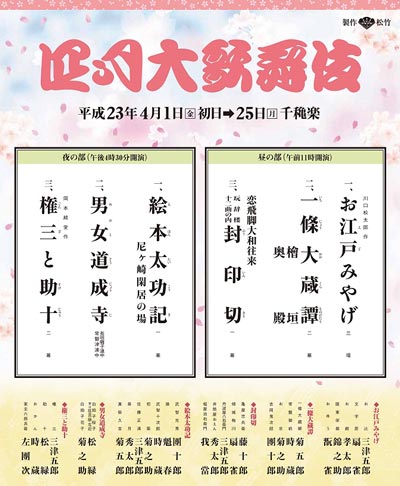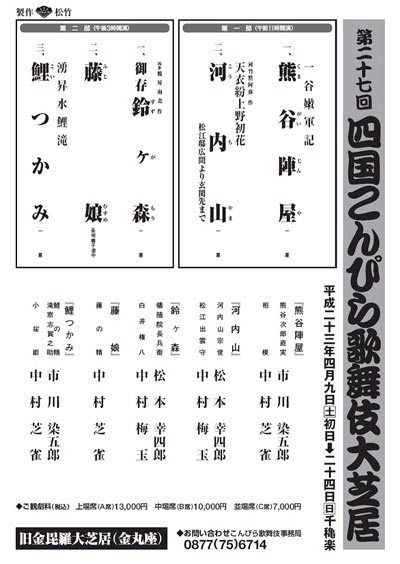| Comments |
Oedo Miyage:
(A Souvenir of Edo)
This modern play is a light comedy with a fanciful episode
from the life of commoners in the Edo period. Two women, Otsuji (Band˘ Mitsugor˘) and Oyű (Nakamura Kanjaku),
who travel annually to Edo to sell the cloth that they weave encounter a young couple. Moved by the spirit of romance,
Otsuji spends all the money that she has made for a once in a lifetime meeting with a fabulously
handsome Kabuki actor (Nakamura Kinnosuke).
Ichij˘ ďkura Monogatari: the world is ruled by Taira no Kiyomori, the leader of the Heike clan.
Tokiwa Gozen, the widow of the head of the defeated Genji clan and mother of Yoritomo and Yoshitsune,
the future leaders of the clan, has become the mistress of the dictator Kiyomori, then the wife of
Lord ďkura, a seemingly simple-minded fool who spends all his time watching pretty women dance.
Outraged members of the Genji clan sneak into Lord ďkura's mansion only to discover that
Tokiwa Gozen's immorality and Lord ďkura's idiocy are a guise, the only way to survive in a world ruled by the enemy.
This performance stars kiku7 as Lord ďkura, Nakamura Tokiz˘ as Tokiwa Gozen,
Ichikawa Danjűr˘ as Yoshioka Kijir˘ and Onoe Kikunosuke as Yoshioka's wife Oky˘.
Fűin Giri:
(Breaking the Seals)
In the pleasure quarters, the most important possessions
were money and reputation. In danger of losing his lover, the courtesan Umegawa,
the money courier Kameya Chűbŕ breaks the seals on a package of money entrusted to him
after being taunted by a rival, even though the use of such money is punishable
by death. Starring Sakata T˘jűr˘ as Chűbŕ, Nakamura Senjaku as Umegawa, Band˘ Mitsugor˘ as Chűbŕ's treacherous friend
Tanbaya Hachiemon, Kataoka Hidetar˘ as Oen, the proprietress of the teahouse,
and Kataoka Gat˘ as Jiemon.
Amagasaki Kankyo: Akechi Mitsuhide (known in this play as Takechi Mitsuhide) is known as the "three day ruler of Japan", having only control
for a brief time after attacking and killing Oda Nobunaga (known in this play as Harunaga) and before being
defeated in turn by Toyotomi Hideyoshi (known in this play as Mashiba Hisayoshi).
In the most famous act of this play, after assassinating Harunaga, Mitsuhide comes to see his mother,
but she refuses to forgive him for betraying his lord. Mitsuhide sees his son and mother both die before
his eyes as he tries to defeat his rival Hisayoshi, but instead is confronted with the drama of his own
immediate family. Starring Ichikawa Danjűr˘ and Onoe Kikugor˘ as Mitsuhide and Hisayoshi.
Featuring also Nakamura Kaishun, Nakamura Tokiz˘, Onoe Kikunosuke, Kataoka Hidetar˘ and Band˘ Mitsugor˘
as Mitsuhide's wife Misao, Mitsuhide's son Jűjir˘, Jűjir˘'s fiancee Hatsugiku, Mitsuhide's mother Satsuki and Sat˘ Masakiyo.
Meoto D˘j˘ji: "Musume D˘j˘ji" is based
on a legend about a woman transformed into a serpent out of jealousy and who
destroys a temple bell keeping her from the
object of her love. The original dance shows the spirit of the woman who appears at
D˘j˘ji temple as a dancer who wants to celebrate the dedication of a new bell
and does a series of dances showing the many faces of femininity. In this version
there are two dancers and one is revealed to be a man in disguise and, in the
highlight of the dance, transforms the romantic highpoint of the original piece
into a comic scene by using masks. Starring Onoe Kikunosuke as the female dancer and
Onoe Sh˘roku as the male dancer.
Gonza to Sukejű: in this comedy by Okamoto Kid˘, two palanquin bearers
constantly argue and their wives, but when they witness a murder, it changes
everything in the nagaya tenement where they live. This modern play takes one
of the classic stories of the wise magistrage ďoka Tadasuke and looks at it
from the point of view of common townspeople. Starring Band˘ Mitsugor˘ and Onoe Sh˘roku in the roles of Gonza and Sukejű.
Featuring also Nakamura Tokiz˘ and Ichikawa Sadanji.
Source: Earphone Guide website
|

